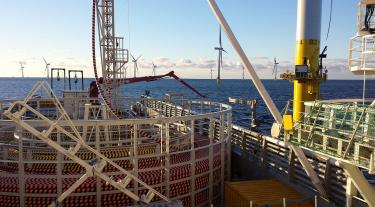The cost-effective design changes are the outcome of the Fibre Optic Cable Protection Assessment project managed by the Carbon Trust and funded by OWA partners EnBW, Equinor, Ørsted, RWE, ScottishPower Renewables, Shell, SSE Renewables, and Vattenfall Wind Power.
In 2017, the UK’s Offshore Wind Programme Board published a review of high voltage export cable reliability, showing that of the seven post-commissioning failures the UK offshore wind industry had experienced, issues in the fibre optic cable were responsible for six. Each failure was estimated to have cost just under £23 million in both the cost of repairs and loss of wind farm energy production.
Following the industry identifying cable failure as a high-profile issue, Ørsted and Nexans each produced modelling to investigate the mechanism of failure, identifying the fibre optic core as the cause. The OWA’s Cables Working Group then commissioned the Fibre Optic Cable Protection Assessment project to validate this modelling, and suggest design recommendations to mitigate risk. This was undertaken by engineering experts at RINA Tech UK.
The five key recommendations are:
- The optical fibres should be encompassed by a stainless steel tube and stainless-steel wire armour, with a combined resistance of no less than 30Ω/km.
- The fibre optic cable sheath should be semi-conductive, with a material resistivity of no greater than 1000Ω∙m, and dimensions such that the radial resistance through the sheath is not more than 75Ω∙m.
- There are to be no insulating binder tapes, adhesives or other insulating material between the armour wires and sheath of the fibre optic cables.
- The three-core cable should have extruded fillers that are made from semi-conducting material, or have a semi-conducting section around the channel for the fibre optic cable.
- The position of the fibre optic cable within the three-core cable remains unchanged from present practice.
The recommendations are likely to increase the cost of the export cable between 0-0.5% depending on the design that it replaces, and will not affect the installation cost. Therefore, overall savings remain significant based on the costs incurred through cable failure.
Ivan Savitsky, Manager of the OWA Cables Working Group, at the Carbon Trust commented:
“Cable failure presents a number of issues for wind farm developers and export cable owners as it is extremely costly to repair, interrupts renewable energy supply, and increases insurance costs for projects. We are pleased to be able to publish the findings from the Fibre Optic Cable Protection Assessment project, and believe that these recommendations will make a significant contribution to reducing the risk of cable failure.”
ENDS
For further information please contact the Carbon Trust press office on +44 (0) 20 7170 7050 or press@carbontrust.com.
Notes to Editors
About the Offshore Wind Accelerator
The Offshore Wind Accelerator (OWA) is the Carbon Trust's flagship collaborative research, development and deployment programme. The joint initiative was set up between the Carbon Trust and nine offshore wind developers in 2008, with the aim to reduce the cost of offshore wind to be competitive with conventional energy generation, as well as provide insights regarding industry standard (and best practice) health and safety requirements.
The current phase involves participation and funding from eight international energy companies: EnBW, Equinor, Ørsted, RWE, ScottishPower Renewables, Shell, SSE Renewables, and Vattenfall Wind Power, who collectively represent 75% of Europe’s installed offshore wind capacity.
About the Carbon Trust
Established in 2001, the Carbon Trust works with businesses, governments and institutions around the world, helping them contribute to, and benefit from, a more sustainable future through carbon reduction, resource efficiency strategies, and commercialising low carbon businesses, systems and technologies.
The Carbon Trust:
- works with corporates and governments, helping them to align their strategies with climate science and meet the goals of the Paris Agreement
- provides expert advice and assurance, giving investors and financial institutions the confidence that green finance will have genuinely green outcomes
- supports the development of low carbon technologies and solutions, building the foundations for the energy system of the future.
Headquartered in London, the Carbon Trust has a global team of 200 staff, representing over 30 nationalities based across five continents.


